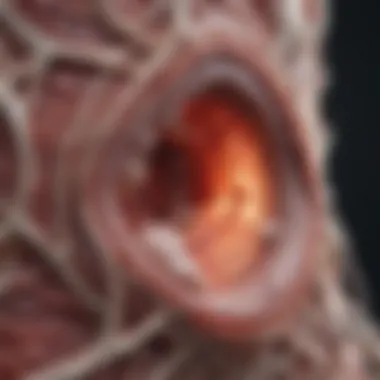Understanding Calcium Buildup in Arteries


Intro
Calcium buildup in the arteries is a pressing health issue, interlinked with serious conditions such as cardiovascular disease. Understanding this topic requires distinct exploration into the mechanisms behind arterial calcification. Through a focused lens, one can discern how various factors like aging, lifestyle choices, and overall health significantly contribute to this phenomenon.
This article aims to elucidate the biochemical processes at play, facilitating insight into prevention and management strategies. By identifying the root causes of arterial calcification, individuals can take proactive steps to safeguard their cardiovascular health.
Key Concepts
Definition of Primary Terms
- Arterial Calcification: This medical condition refers to the accumulation of calcium salts in the arterial walls. It leads to stiffening of the arteries, reducing their elasticity and adversely affecting blood flow.
- Vascular Health: A term encompassing the overall condition of the blood vessels in the body. Good vascular health is crucial for optimal circulation and the prevention of heart-related diseases.
- Biochemical Processes: Refers to the complex interactions and reactions at a molecular level that trigger arterial calcification. Understanding these processes is key to developing effective treatment strategies.
Related Concepts and Theories
- Age-Related Changes: The aging process influences various bodily functions, including the regulation of calcium in the arteries. Older adults tend to experience more calcification due to metabolic shifts.
- Oxidative Stress: Elevated levels of oxidative stress can trigger inflammation that contributes to arterial calcification. This is a topic of growing interest in cardiovascular research.
- Dietary Factors: Certain diets, particularly those high in cholesterol and low in vital nutrients, can exacerbate calcium buildup in arteries.
Understanding the biochemical and lifestyle factors that contribute to calcium buildup in arteries is essential for preventing cardiovascular diseases.
Future Directions
Gaps Identified in Current Research
Research has established various risk factors for arterial calcification. However, gaps still exist regarding the specific biochemical pathways involved in this process. More studies are needed to clarify how lifestyle modifications can alter these pathways.
Suggestions for Further Studies
Future research should focus on the following areas:
- The interplay between genetic predispositions and lifestyle choices in promoting arterial calcification.
- Longitudinal studies that track changes in vascular health over decades, correlating these changes with dietary habits and exercise regimens.
- Interventional studies examining the efficacy of specific diets or supplements in reversing or preventing arterial calcification.
Understanding these factors can lead to more effective strategies to combat the rising incidence of cardiovascular disease.
Foreword to Calcium Buildup in Arteries
Calcium buildup in arteries, known medically as vascular calcification, represents a critical concern in cardiovascular health. This condition can lead to significant complications, including heart attacks and strokes. In this section, we will examine why understanding calcium buildup is essential, especially in the context of its role in vascular diseases.
Understanding the causes and mechanics behind arterial calcification will shed light on preventive measures that individuals can take. Arteries play key roles in transporting oxygen-rich blood throughout the body. When calcium collects in these vessels, it can harden and narrow them, disrupting normal blood flow and increasing the risk of serious health issues.
The implications of this buildup extend beyond individual health. With cardiovascular diseases being among the leading causes of death worldwide, investigating their underlying causes is paramount.
Key Points to Consider:
- Impact on Blood Flow: Calcium deposits can impede the flow of blood, leading to insufficient oxygen supply to vital organs.
- Risk Factors: Identifying factors, both lifestyle and genetic, helps in recognizing those at risk.
- Biochemical Processes: Understanding how calcium accumulates in arteries aids in developing targeted therapies.
"Vascular calcification is not just a consequence of aging but a complex process influenced by multiple factors."
By delving into these aspects, we can better understand how to mitigate risks linked to arterial calcification. This awareness can lead to lifestyle changes and medical interventions that promote better heart health.
The Anatomy of Arteries
The anatomy of arteries plays a crucial role in understanding calcium buildup and its impacts. Arteries are the blood vessels that carry oxygen-rich blood away from the heart to various parts of the body. Their structure and functionality are paramount for maintaining normal physiological processes. Thin-walled, elastic, and muscular in nature, arteries adapt to the pressure from flowing blood. This adaptability is essential for healthy blood circulation, yet any alterations in their structure can lead to complications, including calcification.
Vascular Structure and Function
The vascular structure of arteries consists mainly of three layers: the tunica intima, tunica media, and tunica externa.
- Tunica intima: The innermost layer is composed of a thin lining of endothelial cells, which helps in reducing resistance to blood flow.
- Tunica media: This middle layer contains smooth muscle cells and elastic fibers, allowing arteries to regulate blood pressure and flow by constricting or dilating.
- Tunica externa: The outer layer provides additional structure and support, containing connective tissue.
Understanding these layers is important. If any of these layers are compromised due to factors like inflammation, high cholesterol, or diabetes, it can trigger a cascade of events leading to arterial calcification. When calcium deposits accumulate, it hardens the artery walls, narrowing the passage and impairing blood flow.
Understanding Healthy Blood Flow
Healthy blood flow is vital for overall cardiovascular health. Proper blood circulation ensures that oxygen and nutrients are delivered efficiently to tissues and organs. Factors influencing blood flow include the elasticity of the arterial walls and the health of the entire cardiovascular system.
When arteries are in good condition, they can expand and contract as needed, maintaining optimal pressure levels. However, with calcium buildup or plaque formation, this elasticity diminishes. Diminished blood flow can result in various health issues, including angina, heart attacks, and strokes.
"Ensuring the proper function of arteries is foundational in preventing serious cardiovascular events."
Epilogue
In summary, anatomy serves as a basis for understanding the significant role arteries play in cardiovascular health. Structural integrity and healthy function of these vessels must be preserved to avoid the detrimental effects of calcium buildup. This understanding equips individuals and health professionals with knowledge to prevent arterial calcification.
Biochemical Basis of Calcium Buildup
Understanding the biochemical basis of calcium buildup in arteries is crucial, as it ties directly into several elements of vascular health. This section illuminates how calcium accumulates within the arterial walls and outlines both the systemic factors and individual behaviors that may contribute to this unwanted process. The significance of comprehending these mechanisms cannot be overstated, particularly for students and professionals focused on cardiovascular health and disease prevention.
Calcium Homeostasis
Calcium homeostasis refers to the regulation of calcium levels in the body, a process that is essential for numerous physiological functions, including muscle contraction, neurotransmitter release, and vascular function. The human body tightly regulates calcium through various hormone mechanisms, primarily involving parathyroid hormone (PTH), vitamin D, and calcitonin.
When addressing calcium buildup, it's vital to acknowledge that disturbances in calcium homeostasis can lead to pathological increases in arterial calcium. For instance, individuals with hyperparathyroidism may exhibit elevated calcium levels, contributing to the development of arterial calcification.


Factors that disrupt calcium homeostasis include:
- Hormonal imbalances: Changes in PTH or vitamin D levels can lead to excess calcium in the bloodstream.
- Dietary factors: High intake of calcium-rich foods, without adequate magnesium and vitamin K, can skew calcium balance.
- Chronic diseases: Conditions like renal insufficiency can deteriorate the body’s ability to maintain calcium levels.
Mechanisms of Calcification
Arterial calcification is a multifaceted process that involves various cellular and molecular mechanisms. Understanding these processes is essential for devising effective prevention and management strategies. The two primary mechanisms of calcification are:
- Metaplasia of vascular smooth muscle cells: In response to injury or stress, vascular smooth muscle cells can transform into cells resembling bone-forming cells, an event that triggers mineral deposition in arterial walls.
- Apoptosis of vascular cells: The programmed cell death of vascular cells can release calcium, which subsequently leads to precipitation and formation of calcified nodules. This occurs in areas where there is inflammation or injury, creating an environment conducive to calcification.
The implications of these mechanisms are far-reaching. Greater understanding of how calcified structures form can aid in identifying those at risk for cardiovascular diseases, leading to early interventions.
It is widely recognized that early detection and intervention in arterial calcification can significantly reduce the risk for adverse cardiovascular events.
In summary, grasping the biochemical basis behind calcium buildup provides insight into both preventative and therapeutic avenues. By examining calcium homeostasis and the various mechanisms of calcification, healthcare professionals can better understand the physiological changes that herald serious health risks. Through targeted research and intervention strategies, it may be possible to mitigate calcium-related arterial diseases, paving the way for healthier vascular systems.
Lifestyle Factors Influencing Arterial Health
Lifestyle choices are critical in determining arterial health and can significantly influence the presence of calcium buildup in the arteries. Factors such as diet, exercise, and harmful habits intertwined in daily life shape vascular health. Each lifestyle factor not only plays an individual role but also interacts with one another, creating a web of influences that can either contribute to or mitigate risks associated with arterial calcification. Understanding this interconnectedness benefits individuals seeking to improve their cardiovascular health and reduce the risk of associated diseases.
Dietary Influences
Diet holds a prominent position in influencing arterial health. What one consumes can either promote a healthy cardiovascular system or lead to harmful conditions, including arterial calcification. Numerous components of the diet play crucial roles.
Role of Calcium-Rich Foods
Incorporating calcium-rich foods into the diet is often seen as beneficial, but it is essential to strike a balance. Calcium is vital for various body functions, including muscular and cardiovascular health. However, excessive intake can lead to complications, especially in the context of calcium buildup in arteries.
Calcium-rich foods, such as dairy products, leafy greens, and fortified items, contribute to maintaining adequate calcium levels. The key characteristic is ensuring these foods are consumed in moderation and balanced with other nutrients. Without compensatory factors like vitamin K, calcium may actually exacerbate arterial issues. Thus, while calcium is important, the unique feature is the necessity of moderation and balance with other vitamins to secure cardiovascular health.
Impact of Vitamin K
Vitamin K plays a crucial part in calcium metabolism, influencing where calcium is deposited in the body. It specifically directs calcium to the bones and away from the arteries, highlighting its significance in preventing arterial calcification. The unique characteristic of vitamin K is its ability to activate proteins that bind calcium within the skeletal system, thus supporting bone health while protecting arterial integrity.
For those focusing on heart health, vitamin K-rich foods like green vegetables, natto, and certain cheeses are essential. The advantage here is clear; incorporating these foods can help mitigate the risks associated with calcium buildup. However, increased intake of vitamin K may not benefit those on anticoagulant medications.
Effects of Processed Foods
Processed foods are generally detrimental to arterial health. High in unhealthy fats, sugars, and sodium, these items contribute to inflammation and oxidative stress, both precursors to calcification. The core issue with processed foods is their high content of trans fats and additives that create an unhealthy environment for arterial functioning.
The characteristic of processed foods is their tendency to promote poor dietary habits. Fast food and snack items often lack essential nutrients and fiber, leading to weight gain and hypertension, both of which increase calcium buildup risks. Avoiding these foods can significantly improve one's cardiovascular profile and promote healthier arteries, making it crucial for individuals interested in lowering their risks.
Exercise and Physical Activity
Physical activity is another lifestyle factor that greatly impacts arterial health. Regular exercise can improve overall cardiovascular function, enhance circulation, and promote a healthy weight. The physiological processes involved in repetitive, structured exercise help maintain a balanced cholesterol level and reduce inflammation, thus directly influencing the risk of calcification. Importantly, exercising also improves insulin sensitivity, further protecting against conditions that can lead to arterial damage.
Smoking and Its Effects
Smoking is a well-documented risk factor for various health issues, including acute and chronic cardiovascular diseases. The harmful effects of nicotine and other toxins in cigarettes lead to vascular inflammation and damage the endothelium, the layer of cells lining the blood vessels. With increased vascular damage comes a heightened risk of calcium buildup. Smoking cessation is one of the most significant lifestyle changes an individual can make to improve arterial health.
"Abandoning tobacco can reverse some of the damage done to arteries, thereby reducing the risk of calcification and promoting a longer, healthier life."
Age-Related Changes in Arterial Structure
The impact of age on arterial structure is a critical aspect when examining the causes of calcium buildup in arteries. As individuals age, their cardiovascular system undergoes various transformations, making it more susceptible to calcification. Understanding these changes is essential for developing preventative strategies against cardiovascular diseases that often stem from arterial calcification.
The Aging Process and Vascular Health
Aging is a complex process that affects all biological systems, and the vascular health is no exception. As people advance in age, several changes occur within their arteries. These modifications include the thickening of the arterial walls, loss of elasticity, and a gradual buildup of calcium. Each of these changes can significantly impair the efficient flow of blood, which is critical for maintaining overall health.
Research indicates that endothelium, the inner layer of blood vessels, becomes less effective in regulating blood flow as a person ages. The endothelial function is crucial not only for blood flow but also for preventing platelets from aggregating, which leads to a higher risk of thrombosis. This decline in endothelial function accelerates the process of calcium buildup, further contributing to the risk of cardiovascular diseases.
- Increased Arterial Stiffness:
Aging can lead to an increase in arterial stiffness, which is often measured by pulse wave velocity. Stiffer arteries are less able to expand and contract easily. This stiffness raises blood pressure and can further encourage the calcification process. - Inflammatory Responses:
Inflammation also tends to increase with age. Chronic inflammation can prompt the deposition of calcium in the arterial walls. Numerous research studies support the link between age-related inflammation and vascular calcification, highlighting its role as a significant risk factor for heart disease.
Role of Hormonal Changes
Hormones play a significant role in maintaining vascular health throughout life. However, with aging comes a shift in hormonal levels, creating an environment conducive to arterial calcification. Changes in hormones such as estrogen and testosterone can have profound effects on vascular function.
- Estrogen Levels:
In women, the reduction of estrogen, especially after menopause, can lead to increased risks of vascular disease. Estrogen is known to have protective effects on the arterial walls by helping to regulate cholesterol levels and maintaining endothelial function. Lower levels can promote calcification in the arteries. - Testosterone Levels:
In men, declining testosterone levels with age may also influence vascular health. Low testosterone has been linked with increased arterial stiffness and calcification. As a consequence, both men and women face heightened risks of cardiovascular issues as they navigate the changes associated with aging.
Evaluating these changes is pivotal in understanding the risk factors associated with arterial calcification. More research is needed to delineate the exact mechanisms involved, but being aware of these age-related alterations can lead to better preventive measures.
The interplay of aging and hormonal dynamics creates a complex environment, necessitating targeted approaches for better cardiovascular health in aging populations.
Health Conditions Associated with Calcification
Calcium buildup in arteries is not merely a result of aging or dietary choices; it is significantly influenced by various health conditions. Understanding the relationship between these conditions and arterial calcification is crucial because it provides insights into preventive strategies and potential management. This section explores how hypertension, diabetes mellitus, and chronic kidney disease contribute to calcium buildup, illustrating the intricate link between overall health and vascular integrity.
Hypertension and Its Impact
Hypertension, or high blood pressure, plays a pivotal role in the development of arterial calcification. When blood pressure remains elevated, the walls of the arteries endure increased stress. Over time, this stress can damage the endothelium, the inner lining of blood vessels. In response to this injury, calcium deposits may accumulate at the site of damage as part of a reparative process.


Moreover, high blood pressure can disrupt normal calcium homeostasis in the body, leading to increased levels of calcium in the bloodstream. This excess calcium may get deposited in the arteries, contributing to calcification.
"Managing hypertension is not just about lowering blood pressure; it's also key to preserving vascular health."
Diabetes Mellitus and Vascular Health
Diabetes mellitus is another significant factor associated with arterial calcification. People with diabetes often exhibit an abnormal accumulation of advanced glycation end products (AGEs), which can contribute to inflammation and oxidative stress in blood vessels. This inflammatory environment fosters the calcification process.
Further, diabetes disrupts endothelial function, impairing the ability of blood vessels to maintain normal blood flow. As a result, the risk of developing atherosclerosis increases. In this context, calcium can deposit in the arterial walls as a consequence of both the inflammatory response and the deteriorated vascular function linked to diabetes.
Chronic Kidney Disease and Arterial Calcification
Chronic kidney disease (CKD) has a direct correlation with arterial calcification. The kidneys play a crucial role in regulating calcium and phosphate levels in the body. When kidney function declines, it can lead to mineral imbalances, particularly the accumulation of phosphate. High phosphate levels promote calcification in the arterial walls, significantly increasing the cardiovascular risks associated with CKD.
Additionally, patients with chronic kidney disease often experience secondary hyperparathyroidism, where parathyroid hormone levels become elevated in response to low calcium levels. This hormone promotes the release of calcium from bone, further complicating the scenario and contributing to vascular calcification.
Understanding these health conditions and their impact on arterial calcification helps in devising targeted preventive measures. Managing hypertension, controlling blood sugar in diabetes, and addressing kidney health can play significant roles in reducing the risk of calcium buildup in arteries, thus supporting overall cardiovascular health.
Genetic Predispositions to Arterial Calcification
Understanding genetic predispositions to arterial calcification is crucial for comprehending why some individuals are more susceptible to this condition than others. Genetics play a vital role in various aspects of health, including cardiovascular issues. This section explores Familial Hypercholesterolemia and genetic markers that influence vascular health.
Familial Hypercholesterolemia
Familial Hypercholesterolemia (FH) is a genetic disorder characterized by high cholesterol levels, particularly low-density lipoprotein (LDL) cholesterol. This condition is significant because individuals with FH have a considerably increased risk of developing coronary artery disease due to early arterial calcification. The condition is often inherited in an autosomal dominant pattern, which means that one copy of the altered gene is sufficient to increase disease risk.
People with FH often show symptoms of cholesterol buildup early in life, leading to premature cardiovascular events. As such, identifying this genetic predisposition can facilitate early monitoring and treatment. Furthermore, screening family members of affected individuals can uncover additional cases.
"Early detection of Familial Hypercholesterolemia can profoundly impact the management of cardiovascular risk factors, potentially preventing severe health consequences."
The primary gene associated with FH is the LDLR gene, which encodes for the LDL receptor responsible for clearing LDL from the bloodstream. Mutations in this gene can lead to reduced clearance of LDL cholesterol, resulting in elevated levels and subsequent calcification in arteries.
Genetic Markers of Vascular Disease
In addition to conditions like FH, there are several genetic markers linked to vascular health. Genetic studies have identified multiple single nucleotide polymorphisms (SNPs) that are associated with a predisposition to vascular diseases, including arterial calcification. These markers can serve as indicators of an individual's risk profile.
Some notable genetic markers include:
- ApoE Gene: Variations in the ApoE gene can influence cholesterol metabolism, impacting the likelihood of arterial calcification.
- Matrix Gla Protein (MGP): This protein is vital for inhibiting vascular calcification. Genetic variations affecting its function may lead to increased calcification.
- KLOTHO Gene: Studies suggest that this gene may play a role in aging and vascular health, with some polymorphisms being linked to arterial stiffness and calcification.
Identifying these markers can lead to targeted interventions and personalized medicine approaches. Such advances empower healthcare professionals to customize lifestyle recommendations and therapeutic strategies according to individual genetic profiles.
Diagnostic Approaches to Identifying Calcium Build-Up
Identifying calcium buildup in the arteries is crucial for preventing cardiovascular diseases. This section highlights methods and techniques that healthcare professionals use to detect arterial calcification. Early diagnosis of calcium buildup can help in planning effective interventions and improving patient outcomes.
Imaging Techniques
CT Scans
CT scans, or computed tomography scans, represent a vital tool in diagnosing calcium buildup. They provide cross-sectional images of blood vessels, offering insight into the structure and presence of calcified plaques. The "key characteristic" of CT scans is their ability to detect subtle variations in tissue density, allowing for accurate identification of even small deposits of calcium.
CT scans are a beneficial choice due to their wide availability and quick procedure time. In this article, their unique feature is the capacity to quantify calcium burden, a critical factor in assessing cardiovascular risk. However, a disadvantage of CT scans is their exposure to ionizing radiation, which may raise concerns for some patients, especially when repeated imaging is necessary.
Ultrasound Imaging
Ultrasound imaging is another effective method for evaluating calcium buildup. It uses high-frequency sound waves to generate images of blood vessels. The key characteristic of ultrasound is its non-invasive nature and the absence of ionizing radiation, making it a safer option for many patients. Ultrasound can detect calcified areas and assess blood vessel elasticity, which is pertinent to overall vascular health.
In this context, the advantage of ultrasound is that it can be performed rapidly and provides real-time images. However, its limitation lies in the operator experience; the quality of the images can vary significantly based on the technician's skill.
Biochemical Markers in Blood Tests
Evaluating biochemical markers in blood tests provides an indirect approach to identifying arterial calcification. Blood tests can measure levels of specific substances associated with vascular health, such as lipid profiles and inflammatory markers. Elevated levels of certain markers could indicate a heightened risk of calcium buildup.
Common markers to look for include:
- C-reactive protein (CRP): Elevated levels indicate inflammation, which may correlate with calcification.
- Lipid levels: High cholesterol levels, particularly low-density lipoprotein (LDL), are associated with increased calcification risk.
Strategies for Prevention and Management
Calcium buildup in arteries poses significant risks to cardiovascular health. Thus, implementing effective strategies for prevention and management is essential. This section outlines several approaches, focusing on lifestyle modifications and medical interventions. Each element plays a vital role in helping individuals maintain better arterial health and reduce the risk of complications associated with calcification.
Lifestyle Modifications
Nutritional Guidance
Nutritional guidance focuses on the consumption of healthy foods to support vascular health. By adhering to a balanced diet, individuals can influence calcium metabolism and reduce unwanted buildup in the arteries. Key characteristics of nutritional guidance include promoting whole foods such as fruits, vegetables, whole grains, and lean proteins while minimizing processed foods. A core advantage of this approach is that it encourages dietary diversity, which can help prevent deficiencies in essential nutrients.
Furthermore, specific dietary elements, such as Vitamin K2, are thought to play a crucial role in preventing vascular calcification. This vitamin aids in directing calcium away from the arteries and into the bones, where it belongs. As such, incorporating foods rich in Vitamin K2, like fermented foods and certain cheeses, becomes a vital consideration. While making these dietary changes may present challenges, the long-term benefits for heart health cannot be overstated.
Regular Physical Activity


Regular physical activity is another cornerstone of lifestyle modification aimed at managing calcium buildup. This approach promotes improved blood flow and vascular function, which in turn can help mitigate the risk of calcification. A key characteristic of regular physical activity is its accessibility; individuals can engage in various exercises based on their abilities and preferences.
Moreover, engaging in activities like walking, swimming, or cycling can significantly contribute to cardiovascular health by enhancing the muscular system and promoting overall endurance. Unique to this strategy is its versatility; whether through structured exercise regimens or daily activities, every effort counts. While some may find it challenging to establish a consistent routine, the advantages of increased mobility, better mood, and reduced cardiovascular risks are substantial and can lead to a healthier life overall.
Medical Interventions
Pharmaceutical Approaches
Pharmaceutical approaches include medications aimed at managing calcium buildup and preventing further complications. This method is particularly useful in individuals already experiencing significant issues related to calcification. The primary characteristic of this approach is its targeted action; these medications, such as statins or calcium channel blockers, can help lower cholesterol levels and manage hypertension.
One advantage of using pharmaceutical options is that they provide a relatively quick avenue for intervention, especially in cases where lifestyle modifications alone may not suffice. However, the unique feature of these medications includes the need for ongoing monitoring and possible adjustments in treatment. Patients must also assess potential side effects with their healthcare providers to ensure optimal outcomes.
Surgical Procedures
Surgical procedures may become necessary for severe cases of arterial calcification. These interventions aim to restore proper blood flow and prevent cardiovascular events. A key characteristic of surgical options is their definitive nature. Procedures like angioplasty or stent placement can directly address the blockage caused by calcium buildup.
While effective, surgery does carry risks, including infection or complications during recovery. A notable advantage, however, is the potential for immediate improvement in cardiovascular function. Therefore, discussing the potential need for surgical intervention with healthcare professionals is essential for individuals facing significant arterial calcification.
Research Trends in Arterial Calcification
Research into arterial calcification holds great importance in understanding cardiovascular diseases. This area of study not only sheds light on the processes leading to calcium buildup but also highlights preventive measures and treatment options. As the incidence of conditions like coronary artery disease rises, ongoing research grants insights that can make significant impacts on patient care. Furthermore, advances in research methodologies, including imaging techniques and molecular biology, enrich our comprehension of arterial health.
Emerging Studies and Their Findings
Recent studies have endeavored to uncover the intricate mechanisms that lead to arterial calcification. For instance, researchers have found connections between systemic inflammation and calcification processes in arteries. This discovery emphasizes the need to monitor inflammatory markers in patients at risk of cardiovascular diseases. Additional studies have also indicated that certain medications, such as statins, may influence vascular calcification despite their primary use in cholesterol management.
Another noteworthy trend is the role of gut microbiota. Emerging scientific literature suggests that the composition of gut bacteria may influence the health of arteries. A balanced microbiome could potentially reduce the risk of calcification through several pathways, including metabolic effects. This observation opens new avenues for therapeutic approaches, focusing on diet and the maintenance of a healthy gut.
Research has also highlighted the significance of vitamin K2 in regulating calcium metabolism. Observations indicate that adequate levels of this nutrient might prevent arterial calcification. These findings stress the importance of nutritional factors and prompt further investigation into dietary recommendations.
Future Directions in Research
Looking ahead, the future of research in arterial calcification appears to be multifaceted. A greater emphasis on personalized medicine is likely, as scientists aim to tailor interventions based on individual genetic predispositions and lifestyle factors. Prospective research could explore new biomarkers that can predict early calcium deposits, enabling preventative strategies to be implemented sooner.
Additionally, the interplay between environmental factors and arterial health warrants thorough examination. Investigating how pollution and exposure to toxins impact vascular calcification could lead to significant insights and policy-driven changes to improve public health.
The evolving landscape of technology also suggests that artificial intelligence and machine learning will revolutionize the identification and treatment of arterial calcification. These tools can analyze extensive datasets more efficiently, identifying patterns that may not be evident to human researchers. As a result, researchers may develop predictive models that guide medical practice to enhance patient outcomes.
Ongoing research is crucial, as it feeds into the cycle of knowledge that enables healthcare professionals to combat cardiovascular disease effectively.
Impact of Calcium Buildup on Cardiovascular Disease
Calcium buildup in arteries plays a pivotal role in the onset and progression of cardiovascular diseases. This buildup, often referred to as arterial calcification, leads to a myriad of health problems, primarily affecting the heart and blood vessels. Understanding this impact is crucial for recognizing the risk factors and potential interventions.
Arterial calcification contributes significantly to coronary artery disease and stroke. This relationship underscores the importance of maintaining vascular health. By examining how calcification affects blood flow and pressure within arteries, we can better appreciate its serious implications.
For instance, calcified arteries tend to lose their elasticity, which can elevate blood pressure and hinder blood flow to vital organs. This insufficient blood supply can lead to chest pain, heart attacks, and even heart failure. Moreover, studies suggest that this buildup might increase the risk of plaque rupture, which can trigger acute cardiovascular events.
When discussing the broader influences of calcium buildup, it is vital to consider:
- Chronic Inflammation: Chronic inflammation often accompanies calcification, which can exacerbate vascular issues.
- Oxygen Deprivation: Reduced blood flow can deprive tissues of necessary oxygen, resulting in further complications.
- Systemic Factors: Diseases like diabetes and hypertension intensify the effects of arterial calcification, creating a vicious cycle that can be difficult to break.
"Understanding the impact of arterial calcification is essential for developing effective preventive strategies and treatments."
Given these considerations, it is clear why calcium buildup warrants serious discussion. Addressing calcium accumulation in arteries can help mitigate the risk of life-threatening cardiovascular diseases and enhance overall heart health.
Coronary Artery Disease
Coronary artery disease is a direct consequence of calcium buildup in the arteries. When calcium deposits accumulate within the coronary arteries, it leads to the hardening and narrowing of these important vessels, often referred to as atherosclerosis.
This narrowing restricts blood flow to the heart muscle, resulting in several potential complications:
- Angina: Chest pain that results from reduced blood flow, often triggered by physical exertion or stress.
- Heart Attacks: Severe blockages can completely obstruct blood flow, causing damage to heart tissue.
- Arrhythmias: Irregular heartbeats may occur as a result of decreased oxygen supply to the heart.
In patients with calcium deposits, risk factors such as smoking, high cholesterol, and a sedentary lifestyle can significantly exacerbate symptoms. Therefore, recognizing these risks is crucial in managing and preventing coronary artery disease.
Stroke Risk and Mechanisms
The risk of stroke is also markedly increased in individuals with arterial calcification. When arterial walls harden, plaques can form, leading to two primary types of strokes:
- Ischemic Stroke: Occurs when blood flow to a part of the brain is obstructed by a clot, often formed from plaque rupture.
- Hemorrhagic Stroke: May result from the rupture of weakened blood vessels caused by the pressure of calcified arteries.
Mechanically, the thickening of arterial walls due to calcium buildup creates turbulent blood flow. This turbulence can lead to clot formation. Moreover, in chronic cases, the calcified area might become unstable, heightening the probability of sudden plaque rupture.
The clinical implications of these mechanisms emphasize the need for regular monitoring of vascular health, especially for individuals predisposed to calcification. Detection and management strategies can play a critical role in reducing stroke incidents.
In summary, understanding the impact of calcium buildup on cardiovascular health provides insights into its significant role in diseases like coronary artery disease and stroke. Continued research and awareness are key to developing preventive strategies and enhancing patient outcomes.
Ending
The conclusion section serves as the culmination of the insights shared throughout this article on calcium buildup in arteries. It distills the essential elements discussed, providing a clear perspective on the causes, implications, and management of this condition.
A key takeaway from the exploration is the multifaceted nature of calcium buildup. Factors such as age, lifestyle choices, and existing health conditions intertwine to influence vascular health. Recognizing these aspects can empower individuals to make informed decisions regarding their cardiovascular well-being.
Understanding how dietary factors, physical activity, and genetic predispositions contribute to arterial calcification emphasizes the importance of a holistic approach to heart health. This combined knowledge enables proactive engagement in prevention strategies, which can significantly reduce the risk of developing related conditions, such as coronary artery disease and stroke.
Furthermore, recognizing the impact of systemic health conditions like diabetes and hypertension reinforces the necessity for regular medical check-ups. By being vigilant and aware, individuals can adapt their lifestyle in ways that promote better vascular health.
In summary, informed awareness about calcium buildup in arteries is essential for mitigating risks associated with cardiovascular diseases.



